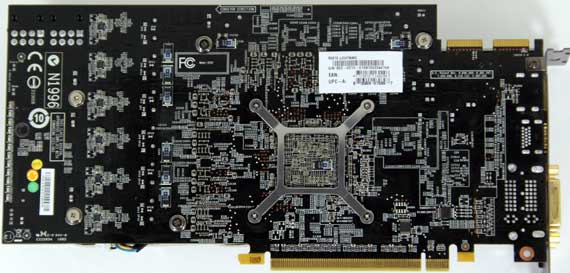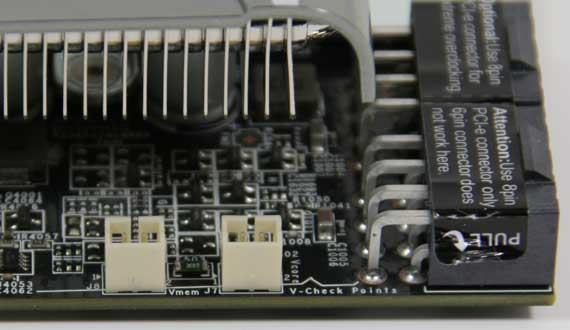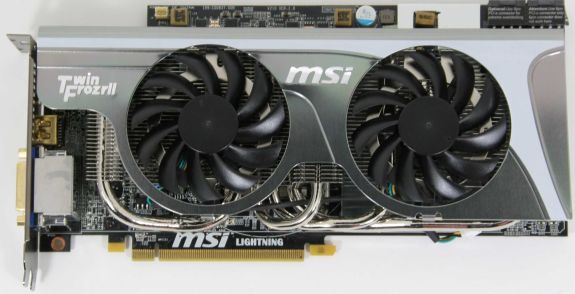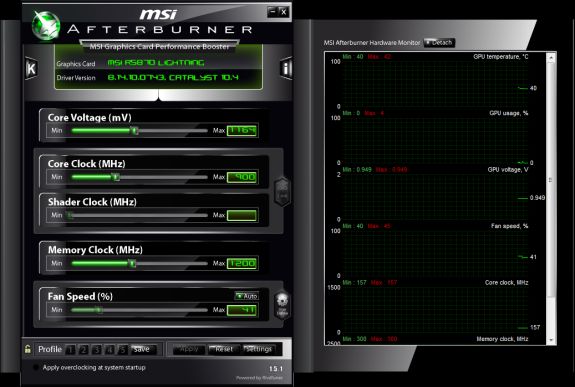Overclocked: Our Custom Radeon HD 5870 Roundup
by Ryan Smith on May 19, 2010 11:53 AM ESTMSI Radeon HD 5870 Lightning
Next up we have MSI’s Radeon HD 5870 Lightning, the latest in their line of overclocker-focused video cards. The 5870 Lightning is perhaps the boldest Lightning yet, deviating quite a bit from the 5870’s reference design.
At the heart of the Lightning is MSI’s custom PCB, an unusually sized board with no existing peer. Notably the board is slightly taller than a standard board, giving MSI a bit more room to put components and traces. The extra 2/3rds of an inch in height shouldn’t be a problem in any case that we’ve seen, but it bears mentioning. Meanwhile the card measures a bit over 10.2” in length, shorter than the reference 5870.

MSI went all-out for power delivery on the Lightning, outfitting the card with a total of 15 VRM phases – 12 for the GPU and 3 for the memory & memory controller. Additional phases usually reduce power efficiency some, but it helps to better deliver power under high load. As a way to display these VRMs, there are 12 LED lights on the back of the card representing the 12 phases for the GPU, which light up to indicate how many of the phases are active.

Feeding those VRM phases is a pair of 8pin PCIe power sockets, another unusual quirk for a video card. As we know, 6pin + 8pin is enough to reach the 300W limit of the ATX spec, so a 8pin + 8pin is a pretty loud declaration that MSI intends to push the limit. Even though this is a 1GB 5870 (reference TDP: 188W), the Lightning requires at a minimum 6pin + 8pin power to operate. 8pin power is optional on the second socket, but is highly recommended, especially when overclocking.
Also found on the Lightning’s PCB are 3 sets of voltage check points for use with a multimeter. This is another one of the Lightning series’ trademark features, and while there’s little arguing that it’s overkill when using air cooling, we’re told that they come in handy for the extreme overclockers using liquid nitrogen – it’s that kind of card.

As with the other cards in this roundup, a great deal of the design is focused on component selection. MSI calls their component selection “military class”, calling attention to their otherwise standard use of solid state chokes and solid capacitors. Mixing things up some however is the addition of what MSI are calling Hi-C capacitors, which we believe to be solid tantalum capacitors. Also in use are Proadlizers – a fairly new type of decoupling capacitor from NEC Tokin. Proadilizers in particular are hard to miss due to their size (pictures on the next page) and we aren’t immediately aware of any other cards using them beyond the Lightning and Gigabyte’s Super Overclock.
For cooling purposes MSI has equipped the Lightning with one of their Twin Frozer II heatsinks, composed of a card-sized aluminum heatsink with 4 heatpipes running to the baseplate. Sitting atop the heatsink is a pair of 80mm fans and a small metal cover that does little to direct airflow, resulting in the card directing air out in all directions. As this card is another design that recycles air in the case you’ll want a well-ventilated case to deal with this.
MSI ships the card with a the smallest factory overclock of the cards in our roundup, coming in at 900MHz for the core and 1.2GHz (4.8GHz effective) for the RAM, the latter of which is unchanged from the reference design. This puts the Lightning’s core clock at 50MHz (6%) faster than the reference 5870. Notably the core voltage is unchanged from the reference design – it’s still 1.165v.

Meanwhile the port configuration is the standard Eyefinity configuration of 2xDVI, 1x DP, and 1x HDMI. This leaves the card with a half-slot vent, reiterating the fact that this card requires a well-ventilated case to get the appropriate airflow.
Finally, as an overclocking card MSI has augmented the hardware with their excellent RivaTuner-based Afterburner software suite, which provides direct control over and monitoring of the card. Through Afterburner MSI allows you to increase the core voltage by up to 15%, topping out at 1.35v. As you’ll see in our overclocking section, this is a pretty hefty range intended for exotic cooling solutions, as the Twin Frozr II cooler can’t keep up with the heat beyond 1.3v or so.
Pack-in items for the card are a mix of the usual and a few items specifically for the Lightning. You get the usual mix of generic manuals, drivers, CF bridges, and a VGA dongle, but along with that packs in 3 very handy cables for accessing the card’s voltage monitoring points with a multimeter, a pair of 6pin-to-8pin PCIe power adaptors, and a 6ft HDMI cable. The PCIe power adaptors negate any issues with the card’s 8pin PCIe power requirement, although with the amount of power this card can pull we’d strongly suggest having at least 1 real 8pin power cable feeding the card.
The retail price of the card is around $480, similar to the other cards in our roundup. As of this moment it looks to be readily available.













43 Comments
View All Comments
Jediron - Saturday, May 22, 2010 - link
These are not cards for a gamer, but for people who make it a sport to beat the other guys 3Dmark results.Gamers, you'll see it hardly makes a difference, gameexperience is something else then raw, digital FPS numbers. Save yourself alot of cash and buy a default clocked card; that leaves you with enough money to buy your favorite game ;)
cauchy2k - Thursday, May 20, 2010 - link
People should not take into account this near 100 °C ,becuase you can increase fan speeds and lower temps a lot.hglazm - Thursday, May 20, 2010 - link
Either you got a bad chip with the lightning, got an exceptional chip with the Toxic, or did something wrong when overclocking the lightningBecause both of mine hit 1ghz without issue. As well as three of the four 5770 HAWKs my friends have ordered (one hit 980 instead of 1020-1060).
Ninjahedge - Thursday, May 20, 2010 - link
It is always good to see this kind of thing being made and tested, but the thing that gets me is simple.This aint the Celery 300 days. You can't get the equivalent of a more expensive chip for half the price, boost it to 150% with a simple (was it multiplier?) switch and get 80%-90% of the more expensive brother.
I have not really seen much come out in the past few years that warrants throwing that much cash out on something that will be beaten for $100 less in 6 months.
Especially when there really is no game that would need it.
The fact that the makers are still comcentrating on giving you the fastest card that can show nose-hair and blackheads in 3D at 2560 resolution irritates me. Has there been any progress (or push for progress) in an EFFICIENT card that can do what the 4870, or 5800's can do for half the power? Passive (silent) cooling? Half the PRICE?
It would be great to get a card to use 1 6 pin additional power cable (hell, push it further, NO additional power) that would be able to fit into a compact case (Shuttle?) and not sound like a dust-buster in game.
Good article, but disappointing that this is still the direction card makers are going. (also sad that all that $$, all that noise and heat gets you so little in the end...)
Question, have you guys figured out a way to be able to rate the best Bang for the Watt? Some comparison taking compact, quiet, efficient cards and trying to rank them by speed, efficiency, ergonomics and price? Can that be done or is that too many variables?
mapesdhs - Tuesday, May 25, 2010 - link
Good post! I thoroughly agree. Reminds me of how pleased I was with the performance ofthe X1950 I bought in 2006 for 156 UKP, and then again later the excellent results obtained
from an 8800GT (Gigabyte Zalman, 700MHz core) which was only 120 UKP. Decent prices,
nice performance each time.
Prices now are crazy. I've given up waiting for a card that offers a reasonable speed boost
at any kind of similar price point, so instead I've bagged an extra identical 8800GT to have
SLI which should work quite well until the RAM limit becomes a factor (atm I'm not playing
games which need 1GB). I've done the same thing for my new PC build (i7 860), buying two
8800GTs which cost less than 100 UKP total.
As you say, it seems vendors are going all out for high cost cards, which is ironic given we're
supposed to be in the middle of a global recession. Who has the money to buy a $570 card
and sleep easy? On a tight budget, I managed to get some items 2nd-hand, saved a decent
amount (750W PSU 40% cheaper than new, WD VR 150GB half new price), and found an eBay
seller doing the i7 860 at a good price (205 UKP, almost 30 less than any other source) with
free shipping (item 270583690505; he has 5 left. Mine is only running at 3.8GHz atm, but I don't
have the proper fans yet).
When I bought the 8800GT in 2008, I doubled or tripled games fps rates compared to my old
X1950 using the same CPU/RAM (Athlon64 6000+, 4GB DDR2/800), for less than $200. Two
years on once more, doing the same thing isn't possible.
Ian.
Kaihekoa - Thursday, May 20, 2010 - link
Anandtech really needs to get a reliable proofreader. Every article I read has multiple typos which obviously isn't very professional for such a highly regarded tech site. I would do it for free given the subject matter.austonia - Thursday, May 20, 2010 - link
These cards do not OC very well at all. I have a reference-design Sapphire 5850 from about a month after they came out, and it does 900/1300 at stock 1.08v, and 1000/1300 at 1.25v. You would think these 5870s with cherry-picked chips, high end components and cooling system could at least match a stock 5850. And there were quite a few people on overclock.net forums getting similar results. Anyway thanks Anandtech, good info.austonia - Thursday, May 20, 2010 - link
Please consider adding Metro 2033 to the benchmarks, with all of the eyecandy turned up it looks like a slideshow on my 5850. Must need a brutal amount of power. None of the games you are testing now are very challenging for a Fermi or 5850+.Kaihekoa - Thursday, May 20, 2010 - link
I would like to extend my thanks to Anandtech for doing an article about PC hardware instead of writing laptop reviews and copy/pasting press releases. I believe this is a topic of great interest for gamers and hardware enthusiasts: How much benefit do you get out of these pre-overclocked cards with big price premiums. As we can see you don't get much and certainly not enough to justify paying $100 or more extra. I just upgraded my Radeon 4870 to a 5850 that overclocks to 950/5000 without extra voltage. Oh, and I paid $225 for it on ebay meaning I got almost as much performance as these $500 cards for 55% less money.Etern205 - Friday, May 21, 2010 - link
Why no this?http://vr-zone.com/articles/retail-asus-matrix-587...